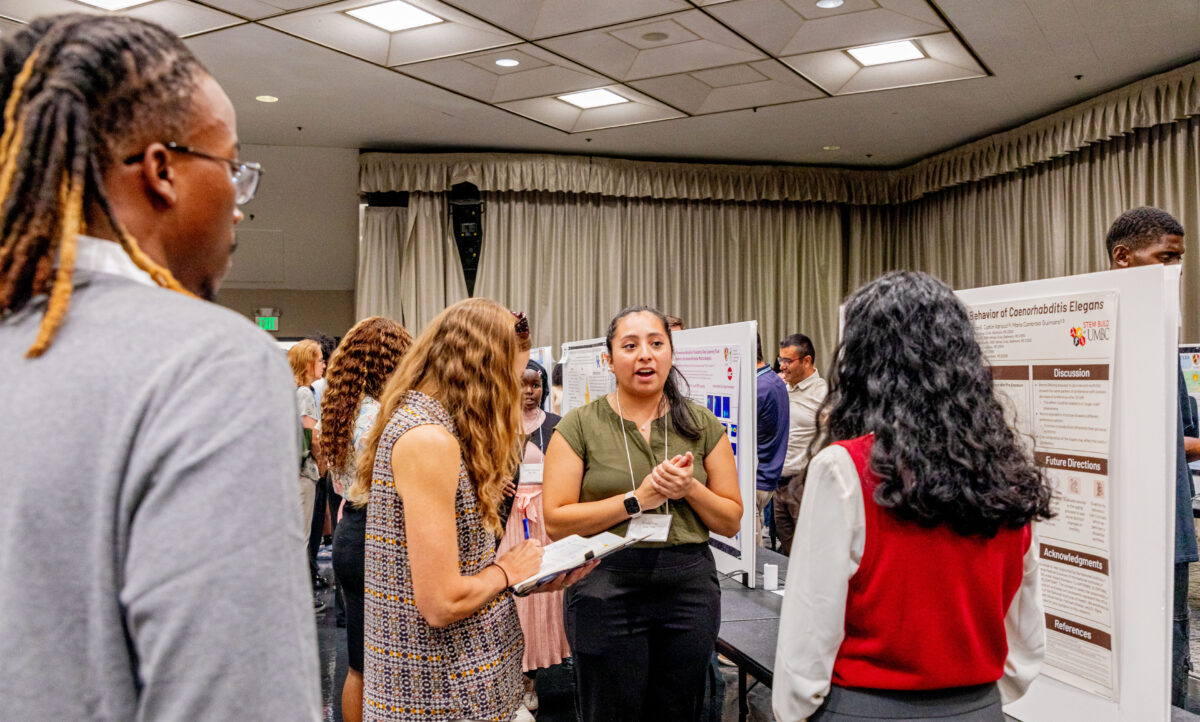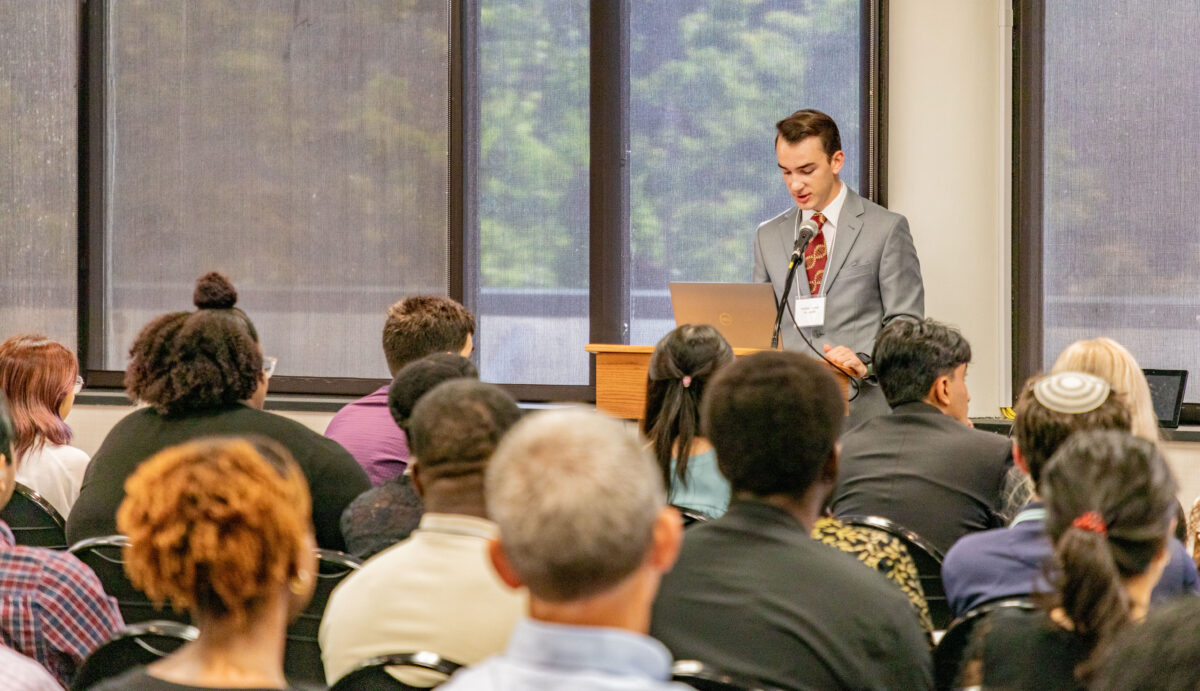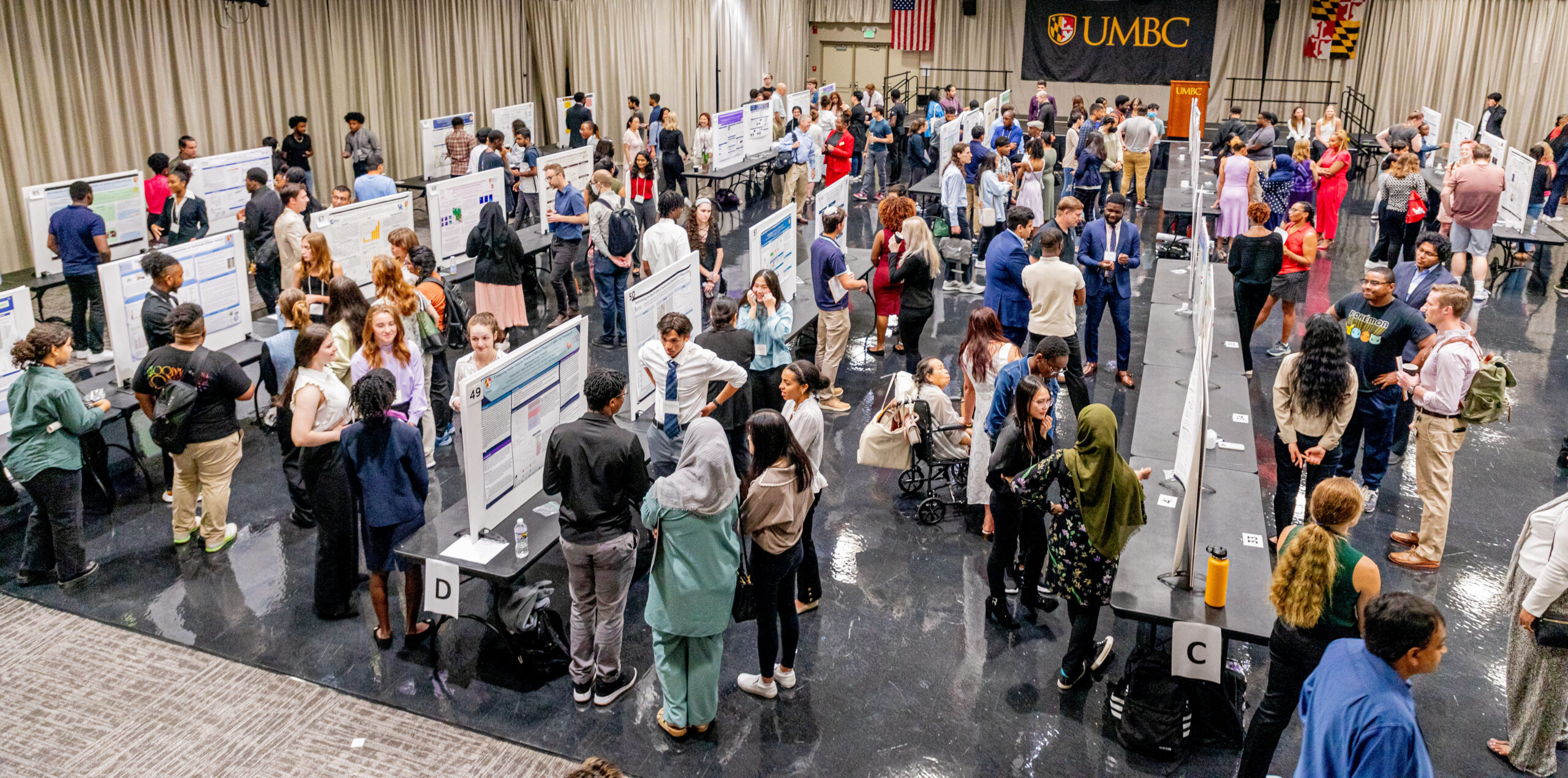At Summer Undergraduate Research Fest (SURF) on August 9, 132 students presented posters and six gave short oral presentations, called “lightning talks,” about research projects covering topics from “forever” chemicals to prostate cancer to alcohol addiction. The University Center Ballroom buzzed with students, mentors, and guests as students shared their progress, interacted with other student researchers, and received feedback. The annual event, sponsored by the College of Natural and Mathematical Sciences (CNMS) since 2005, gives students who are often in the early stages of their research careers an important opportunity to feel like part of a scholarly community.
“We are proud of all that our students accomplished this summer. Now they are more knowledgeable, experienced, and skilled—they are better scientists,” shares CNMS Dean William R. LaCourse. “Their discoveries, their effort, and their willingness to explore have added to the vault of scientific knowledge, which in the end benefits society through empowerment—an empowerment of understanding, prediction, and invention.”
Undergraduate research boosts confidence, opens doors
Community college students who participated in the BUILD a Bridge to STEM Internship, a component of STEM BUILD at UMBC, presented research they conducted in small groups under the mentorship of Maria Cambraia, assistant director of research and international affairs in CNMS. Each group developed a different research question about the earthworm C. elegans, a common model organism, and then designed and carried out experiments to answer that question. The internship operates as a course-based undergraduate research experience, or CURE, a structure designed to create opportunities for more students to gain authentic research experience.
Emily Paz ’25, biological sciences, studied how high sugar diets affected the worms. It was Paz’s first time conducting quantitative research, and the BUILD internship created opportunities to make mistakes and learn from them, she says. “It expanded my career choices, and made me see I really have an interest in this field,” says Paz, a transfer student from Howard Community College.

In addition to work in the lab, the process of preparing for SURF and completing the Introduction to Research Badge as part of the internship was valuable for BUILD intern Emily Molnar, a Montgomery College student whose project focused on the relationship between stress and alcohol in C. elegans. Interns completed the badge, a sequence of activities designed to help them get ready to find and pursue undergraduate research opportunities, under the guidance of Caitlin Varisco, assistant director of undergraduate initiatives in CNMS.
“The internship gave me experience with abstracts, posters, and skills to get future opportunities, which boosted my confidence,” Molnar says.
Belonging in science
Student research at UMBC is frequently student driven, which was the experience of Samuel Barnett ’25, biochemistry and molecular biology, another Howard Community College transfer. His project looked at how nicotine influenced the appetite of C. elegans. “You have so much freedom in this program, which I love,” he says. “That really made me feel involved in the research process.”
Third- and fourth-year UMBC students, some of them former STEM BUILD Trainees, mentored the interns along with Cambraia. “I found it uplifting,” says mentor Courtney De Leon ’25, biological sciences. “I’m so proud of the students I mentored.” De Leon also presented her own project at SURF on how long-term nicotine consumption affected growth and reproduction in C. elegans.

Cambraia notes that after the eight-week internship, the interns identified much more with being scientists than they had at the outset. “Science identity” is documented to increase the chances that students will complete STEM degrees and then continue in related careers.
“That’s why mentoring and peer mentoring are so important in this program,” Cambraia says. “We are not just mentoring them in wet lab techniques, experimental design, and data analysis skills. Our main goal is to help them see and feel that they belong in science and that they can be future leaders in this field.”
“A grand scholarly community”
BUILD a Bridge to STEM is just one example of a student research program that participated in SURF. Students in an array of programs supported by the likes of the National Institutes of Health, Howard Hughes Medical Institute, and the Louis Stokes Alliance for Minority Participation participated, as well as those who arranged their research projects individually.
“These projects all depend on mentors supporting undergraduate research with their time, energy, and resources,” LaCourse notes. UMBC faculty have shown time and again that they are happy to work with students to help them reach their goals, as evidenced by the huge number of students presenting original work at SURF. For many students, SURF is their first time presenting research—but LaCourse hopes it won’t be the last.
“This may be the first of many scientific talks you give,” he told the participants at the end of the day. “By practicing and applying the skills of performing research this summer, you are following in the footsteps of great scientists and researchers—making each of you a part of a grand scholarly community.”
Tags: Biology, Chemistry and Biochemistry, CNMS, rca-2, STEMBUILD

